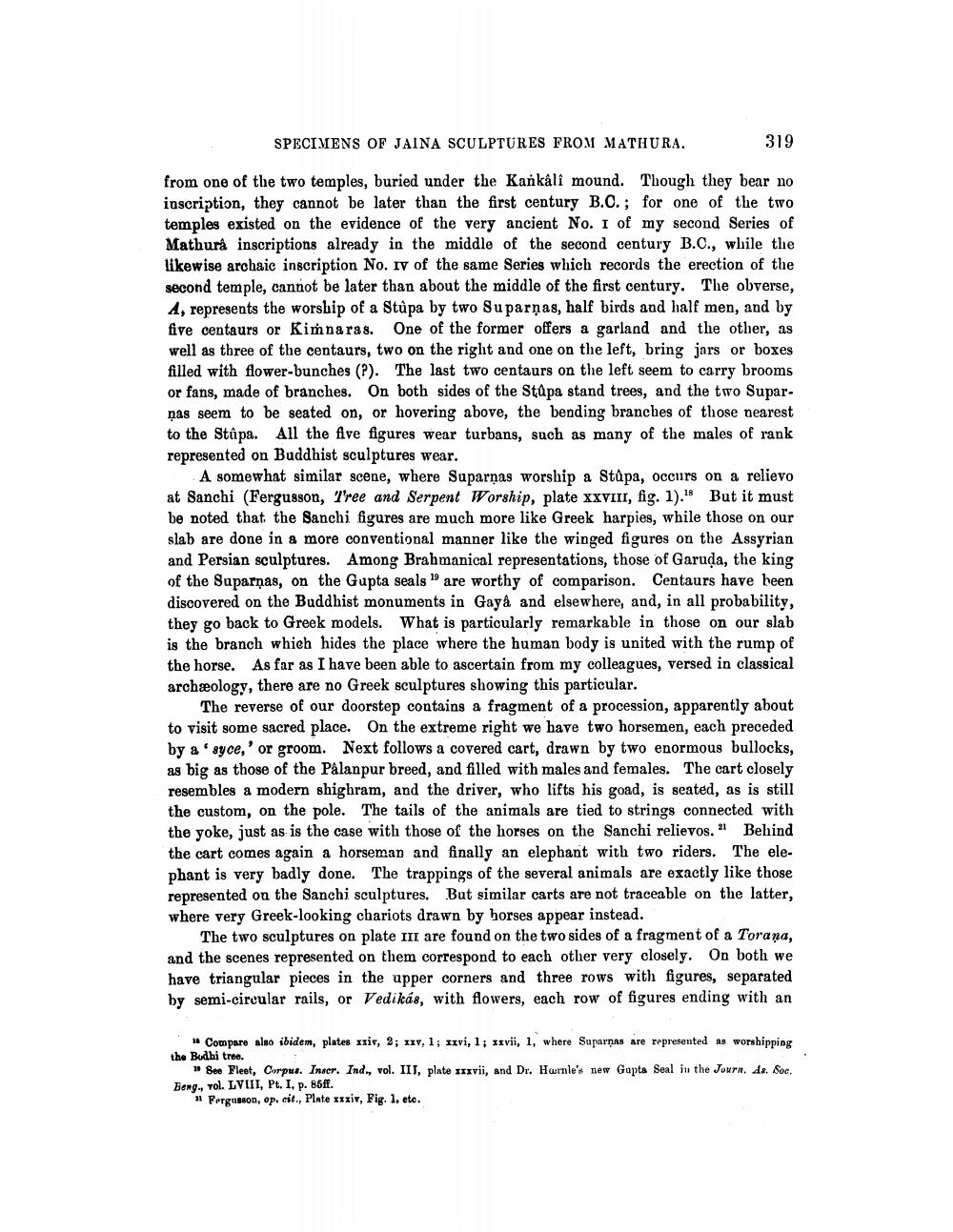________________
SPECIMENS OF JAINA SCULPTURES FROM MATHURA.
319
from one of the two temples, buried under the Kankali mound. Though they bear no inscription, they cannot be later than the first century B.C.; for one of the two temples existed on the evidence of the very ancient No. I of my second Series of Mathura inscriptions already in the middle of the second century B.C., while the likewise archaic inscription No. IV of the same Series which records the erection of the second temple, cannot be later than about the middle of the first century. The obverse, A, represents the worship of a Stûpa by two Suparņas, half birds and half men, and by five centaurs or Kimnaras. One of the former offers a garland and the other, as well as three of the centaurs, two on the right and one on the left, bring jars or boxes filled with flower-bunches (). The last two centaurs on the left seem to carry brooms or fans, made of branches. On both sides of the Stupa stand trees, and the two Suparņas seem to be seated on, or hovering above, the bending branches of those nearest to the Stậpa. All the five figures wear turbans, such as many of the males of rank represented on Buddhist sculptures wear.
A somewhat similar scene, where Suparņas worship a Stúpa, occurs on a relievo at Sanchi (Fergusson, Tree and Serpent Worship, plate XXVIII, fig. 1). But it must be noted that the Sanchi figures are much more like Greek harpies, while those on our slab are done in a more conventional manner like the winged figures on the Assyrian and Persian sculptures. Among Brahmanical representations, those of Garuda, the king of the Suparnas, on the Gupta seals are worthy of comparison. Centaurs have been discovered on the Buddhist monuments in Gayà and elsewhere, and, in all probability, they go back to Greek models. What is particularly remarkable in those on our slab is the branch which hides the place where the human body is united with the rump of the horse. As far as I have been able to ascertain from my colleagues, versed in classical archæology, there are no Greek sculptures showing this particular.
The reverse of our doorstep contains a fragment of a procession, apparently about to visit some sacred place. On the extreme right we have two horsemen, each preceded by asyce,' or groom. Next follows a covered cart, drawn by two enormous bullocks, as big as those of the Palanpur breed, and filled with males and females. The cart closely resembles a modern shighram, and the driver, who lifts his goad, is seated, as is still the custom, on the pole. The tails of the animals are tied to strings connected with the yoke, just as is the case with those of the horses on the Sanchi relievos. Behind the cart comes again a horseman and finally an elephant with two riders. The elephant is very badly done. The trappings of the several animals are exactly like those represented on the Sanchi sculptures. But similar carts are not traceable on the latter, where very Greek-looking chariots drawn by horses appear instead.
The two sculptures on plate III are found on the two sides of a fragment of a Torana, and the scenes represented on them correspond to each other very closely. On both we have triangular pieces in the upper corners and three rows with figures, separated by semi-circular rails, or Vedikás, with flowers, each row of figures ending with an
Compare also ibidem, plates xxiv, 2; xxv, 1; Ixvi, 1; wxvii, 1, where Suparņas are represented as worshipping the Budhi tre
* See Fleet, Corpua. Inser. Ind., vol. IIT, plate sixvii, and Dr. Hwrnle's new Gupta Seal in the Journ. ds. Soc. Beng., vol. LVIII, Pt. I, p. 85ff.
1 Pergnisson, op. cit., Plate xuxiv, Fig. 1. etc.




